Why Click Through Rates are the meat and potatoes of Good SEO and PPC
Whichever KPI you regard as having greatest value will depend upon your business goals. That being said, click through rates are arguably the most vital metric when measuring the effectiveness of both SEO and PPC campaigns for any website.
When judging the success rate of your SEO or PPC strategies, there are many metrics to consider but which is most important?
Whichever KPI you regard as having greatest value will depend upon your business goals. That being said, click through rates are arguably the most vital metric when measuring the effectiveness of both SEO and PPC campaigns for any website.
Click through rate is defined as the number of clicks your site received against the total number of people who had the opportunity to click. CTR is central to positive digital marketing because it reveals how successfully your ad or search listing resonated with the audience to which it was presented.
CTR is the foundation of digital success for both sides of search: organic and paid. If you are looking to increase brand awareness, engagement, traffic or even conversions you need to be considering how you can increase your CTR first.
Why is CTR important for profitable PPC?
For Google AdWords advertisers, CTR is not only one of the most significant metrics when reviewing your campaign, it is actually necessary for your ads to perform well in the first place.
CTR is a vital component in your Google AdWords quality score. In addition to your ad copy, bids and the relevancy of your keywords and landing page, CTR is one of the elements taken into consideration for quality score.
Having a high quality score is a central feature of good Google AdWords’ ad performance and therefore profitable PPC.
So, you now know that CTR matters for quality score but how does this directly control ad performance and how does it make your company money?
A higher quality score means lower CPC, higher potential impressions share and a better ad position. This is true across both the search and display network of Google AdWords.
Naturally, a lower CPC is good for saving money but the correlation between quality score and impression share means that having a good CTR will increase the number of people to whom your ad is eligible to show.
Your impression share is the number of impressions your ads received divided by the estimated number of impressions you were eligible to receive. To reach a big audience you need a high impression share and a positive CTR directly affects this.
In the graph below we can clearly see the correlation between quality score and impression share.
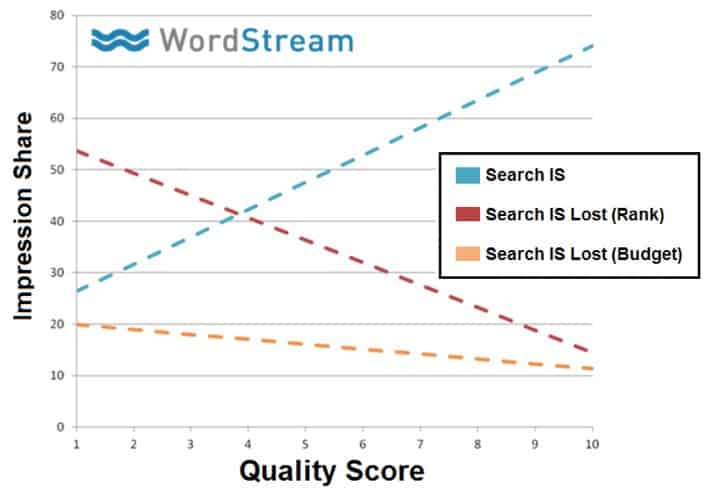
If you succeed in having a high CTR for your ads, it means users liked your ad. They were convinced by what you were offering enough to head over to your website to find out more. If your website manages to not disappoint and keeps the ad’s promises, that user excitement should be enough to continue through to conversion.
According to Wordstream, if you can double CTR, it is quite common that conversion rate will see close to a 50% increase too.
In Google AdWords, a higher CTR creates more impressions and by definition, it means more clicks, hence more chances to convert and create a bigger profit. From this we can see CTR is not just one of many equally important PPC metrics, it is the driving force behind profitable PPC.
Watch the video below to learn more about the Google AdWords quality score and its significance for your campaigns:
www.youtube.com/watch?v=P6RfDHpsyPg
Why is CTR important for good SEO?
CTR has come to be seen as a highly significant metric in SEO. It is easy to see why since, even though SEO is often believed to be all about high rankings, they aren’t good for much if they don’t drive traffic.
SEO has grown to encompass many digital strategies, including CRO and UX design and it shares a close relationship with paid search. Data found in your PPC will aid your SEO and vice versa.
SEO is now primarily about high rankings on the one hand and driving traffic on the other, all with the end goal of pushing conversions.
If driving traffic is one of the major aims of SEO, we can clearly understand why CTR is essential for good SEO.
CTR is a foundation of good SEO because it means more traffic and it is the necessary gateway metric. If your website has a good CTR in organic search you will be able to drive more conversions. It is much harder to drive conversions or have people engage with content on your site if they never read it.
Clicks from organic search, paid search, social posts, paid social and email marketing are all traffic coming to your website, where they can then actually perform actions that might profit you. That’s right, CTR isn’t just about good SEO, it aids sharability, engagement, conversions and micro conversions too.
Some SEO experts could argue that high ranking positions have to come before CTR because the highest ranking sites have the biggest share of clicks.
This is absolutely true, as you can see from the two charts below:
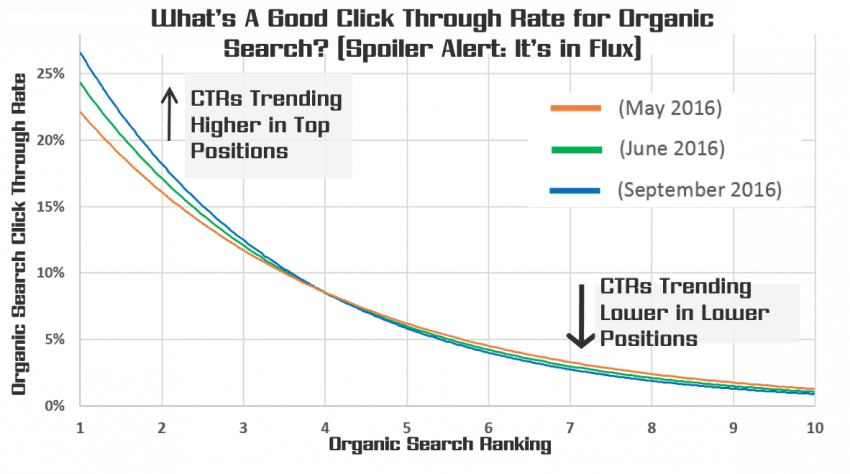

If highest positions means better CTR, then surely rankings must be a more important metric for organic SEO success? Well, no that’s not the case. People desire efficiency. We are told and believe that the highest ranking websites in Google search will be the most relevant to our query. As Google’s algorithms get smarter this is an increasingly accurate statement. However, it is still not a universal truth.
Google is very good at showing us the most relevant results but it doesn’t always get it 100% right. All the results on page one and two of search might be very relevant to our query but we don’t always click the first few results.
There are many reasons why humans would click on a search result below position one. Often, we fail to convey what we are looking for correctly or websites fail to optimise themselves enough for such a specific query. Humans are also as imperfect as computers, if not more so. Maybe the website in position one was more relevant to our query but we chose the site in position three because we have heard of it before or they portrayed a good deal in their title tag. Sometimes what we are looking for does not exist or is rare but shares similar correlating terms to other products and services. This can lead us on a chase, trawling lower through search results.
At the end of the day humans are increasingly tech savvy. We know that sometimes the first result will fail to be the most relevant and this is why CTR is more important than rankings. You can still have a great CTR and push conversions even if you are not in the top rankings positions. High CTR can provide benefits in the absence of a high ranking but not the other way around.
Treating CTR as the essential foundation of your SEO campaign is a good strategy because not all websites can be in the top two ranking positions. For competitive industries, sometimes being number one just isn’t feasible for your biggest priority keywords.
While opting to rank high for long tail keywords is a great solution, marketers should also look to their CTR as well. Using rankings and CTR together is the best way to challenge competitors for competitive search terms. Even if you rank much lower than position one on the first page of Google, if you can get that far and have a more compelling title tag and meta description, you can tempt users away from the top spots.
If CTR is vital for SEO, does that make it a ranking factor?
This debate has been raging for some time.
It seems obvious that Google should take CTR into account. After all it is an important factor for Google AdWords, so why not organic results? It seems only natural Google would reward sites that have successfully resonated with users but the official word from Google is that CTR is not a direct ranking factor.
It is a commonly held belief that good CTR will be rewarded by Google and that high bounce rates would naturally harm your rankings, however Google maintain that this would not be a fair method for ranking websites as, firstly, Google can’t tell if you have a high bounce rate unless you use Google Analytics.
While CTR is used by Google for evaluation and experimentation, it is still not used as a ranking factor. This seems odd but CTR could be falsely manipulated, such as crowdsourcing clicks as described in Search Engine Land’s article.
This seems a little illogical when we consider what a big indicator CTR can be to user satisfaction and relevance. Many SEOs just refuse to accept this as fact. Wordstream and Moz have both undertaken some experiments, which they believe show that there is a distinct correlation between ranking and CTR.
The trouble with this data is that we can never know which comes first. Does good CTR have an impact on organic rankings that Google don’t admit or do sites gain good rankings and therefore have good CTR? It is a classic chicken and egg problem.
Moz and Wordstream are among the industry influencers who believe that there is not only a connection but CTR might more clearly become a ranking factor with the advent of Rank Brain. Moz even directly states that they believe Google does reward sites if the CTR is 20% higher than the expected CTR for their position and their experiments contain some interesting data to support their theory.
With 15% of searches being brand new to Google per day and longer and more complex queries entering Google’s domain (as we increasingly rely on them), Rank Brain could come to play a more primary role. CTR would be a good way to measure the quality of results being shown but we will have to wait and see.
At the end of the day is does not matter if CTR is not a direct ranking factor. We know that without CTR, high rankings cannot serve their purpose and that CTR has valuable indirect benefits which help our digital strategies.
Now we know CTR is a very vital metric but can it really compare to conversion rates or ROI?
How can CTR ever be as important as conversion rates?
Many companies will disagree that CTR is the most important metric, instead citing conversion rates and ROI. After all, conversion rates and ROI are the metrics that directly correlate to profit. However, this is a mistake.
ROI and conversion rates are enormously important, yet they only reveal data about your profit compared to your digital marketing spend and data about the users who have already shown interest in your company. This is really useful data but what you need is to then increase CTR to allow for more of those conversions.
For most, if not all industries, CTR is directly linked to conversion rates, sharability and engagement because you usually have to push traffic to your conversion pages before they can actually convert. The ability of your ads, posts, search listings and links to drive clicks will therefore directly impact profits.
CTR equals high value for both PPC, SEO and even social marketing, affiliate marketing and email marketing because it directly shows how well your link, listing, ad or post resonated with the user.
As you can see from the chart below there is a clear correlation between positive CTR and positive conversion rates.
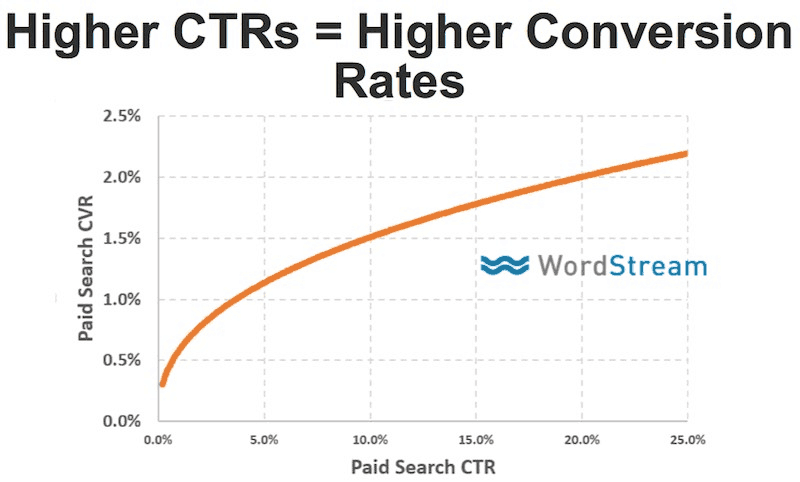
Wordstream agree that when engaging in CRO, you should be looking at CTR as your main metric, rather than conversion rates and that goes for organic search too.
If your CTR is low, while other metrics are high you have a problem. We know that if impressions are high but CTR is low it means your offer isn’t resonating with your target audience or you’re targeting the wrong audience. If conversion rate is high, you could still have a major strategy issue if CTR remains low. You know your product or service is working for the people who end up on your site but there are not enough of them. This is common in ultra-niche industries but it often means your targeting is limited or your ad or listing in search results does not attract people. If your site listing or your ad is failing to communicate the desired message effectively this could spell stagnation and doom for your campaign.
If you are confused about the significance of CTR for influencing conversions just remember that a good CTR means more eyeballs. More eyeballs on your amazing content, services and products means a greater chance of conversions and a higher chance of increased profit.
CTR is arguably the most important metric for Google AdWords marketing and it clearly matters for SEO, CRO, social media and email marketing as well because it’s all about pushing those precious visitors to your content.
You now understand why CTR is the foundation of good SEO and profitable PPC but how can you actually increase CTR?
How to improve your CTR in PPC ads
- Create compelling ad copy – When writing your ad copy don’t forget to include your target keywords. According to PPC experts like Neil Patel, users are far more likely to click and convert if they see their query in your ad.
You should aim to include your most interesting USPs, manipulate common human emotions, such as fear of missing out and desire.
To really stand out, try solving a well-known problem in the ad copy and/or offer a hook like a free trial.
To really take ad copy to the next level use your previous campaign data to create ‘buyer personas’. Study the behaviour and language used by this kind of internet user so you can learn to write copy in a language they can relate to. Jeff Bullas has even more great advice on developing buyer personas for PPC and if you need more in-depth insights into crafting the perfect ad copy head to our previous Paid Traffic blog to learn more.
Here is a perfect example of some great ad copy with keyword placement and excellent USPs.

Here is an example of how ad copy can completely go wrong and misunderstand user intent. This is for the same search query as the ad above – ‘best SEO software’:

If you forget everything else, the most intrinsic rule of great ad copy should be quality and integrity. We have all heard of out manoeuvring competitors and even bidding on their terms but outright criticism in your ads is unnecessary and just looks desperate, so keep it classy:

For more hilarious example of how not to write ad copy explore this guide from Jeffalytics.
- Utilize ad extensions – Including price, location, click to call phone numbers and sitelinks can really help give users all the information they need, make your ad more interesting and take up more space in search results. You could see a 10 – 15% increase in CTR by adding ad extensions.
- Use the right keywords – By employing high-quality keyword research you will be better prepared to target the right terms for your business in your Google AdWords campaigns. Targeting keywords that don’t match your ads or landing pages is a rookie mistake and will frustrate users.
- Target the right people – To improve CTR you need to get your ads in front of people who will relate to them. There are so many targeting choices in AdWords that there is no excuse for sloppy targeting. Advertisers have keywords, demographics, geotargeting, remarketing, similar audiences and for the display network topics and placements. Never stop evaluating your targeting.
- Test your ads – This should be obvious to any experienced advertiser. To improve CTR test different ad styles and duplicate tactics that prove fruitful.
- Analyze the competition – Take a look at the screenshot below:

All the ads have great ad copy, good use of USPs, a free trial hook and extensions. They are examples of strong ads but how do users decide between them? Who deserves to win the best CTR? This is why keeping an eye on competitor ads is a good idea. You need to ensure your ad is special and stands out from everyone else.
Watch their ads closely to make sure your ads are the unicorns of paid search and not just one of the herd.
- Don’t lie or ask silly questions – The drive to create great ad copy should never motivate you to lie. Don’t promise something is free if it isn’t:
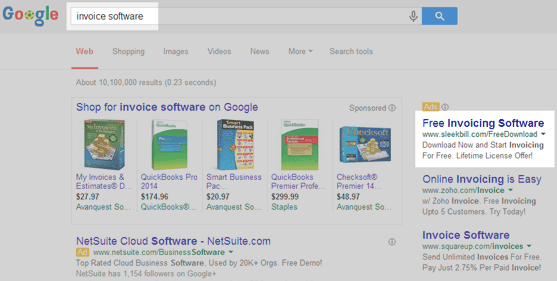
This will repel users and create distrust. Another silly mistake is asking users really obvious questions. The example provided by Neil Patel below is the perfect example:
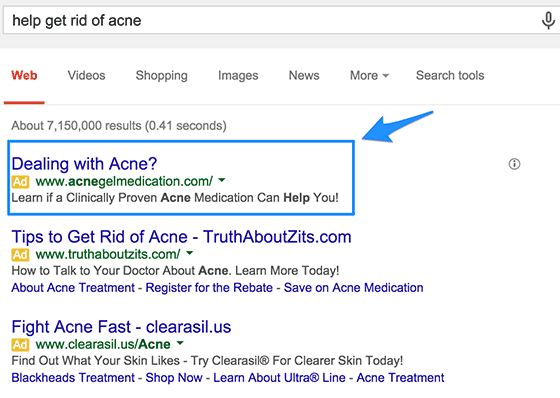
If you have just Googled ‘help get rid of acne’ you don’t need the ad to ask you if you’re dealing with acne. Of course you are, that is why you entered the search and that is a waste of characters.
While it can be frustrating trying to fit all those tactics into a small amount of characters, at least Google has now rolled out expanded text ads, so advertisers have more power to woo their audience. Take a look at our Paid Traffic blog on writing ad copy for expanded text ads for more help.
How to improve your CTR in organic search
- Choose the right title tag – You know title tags are important for your rankings but they are also the first thing users see of your website in search. It is therefore essential that you balance keywords in your title tag with more compelling human language. It is admittedly a challenge with limited characters but thanks to Rank Brain it may become easier in the future. JeffBullas demonstrates this very well in his blog on the subject:
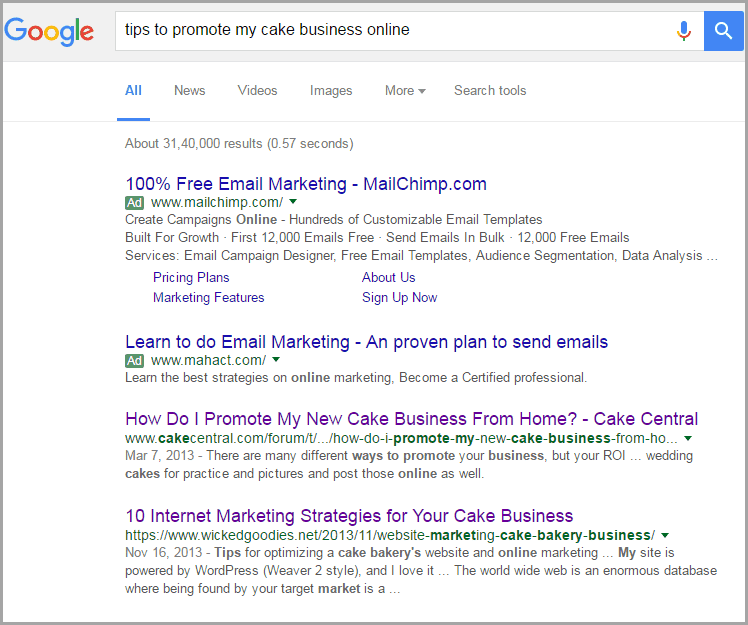
Look at the search query and then to the second search result after the ads. While the title tag does not contain the exact keywords of the query, as result three does, Google can still tell it is a highly relevant piece of content. As humans we know this title tag and the query mean the same thing, despite different phraseology. Hopefully with the improvement of Rank Brain and Google’s ability to understand context, this will make creating content and title tags for humans easier. For now, SEOs must try to balance keywords and compelling offers and hooks for people in title tags.
- Choose a compelling meta description – This takes some of the pressure off title tags by allowing extra characters that do not aid rankings but can directly influence CTR. By creating interesting title tag and meta description copy you can entice users in much the same way as ad copy.
Here is a great example of effective title tag use:

In the following example the site is not making good use of characters for ranking or user engagement.

The title tag does mention the keyword ‘business funding solutions’, although the meta description helps to give some context. Saying contact twice is again a waste of space. Search Engine Land also provides some brilliant examples. Here is a title tag and meta description exquisitely written:

This attempt makes the mistake of putting the brand name first. Always put your most important keywords first and then the brand name:

This is next example is not bad for humans and CTR but might struggle to rank as it begins with stop words:

- Utilize structured data – While you have ad extensions and automated extensions in Google AdWords, you have structured data mark up in organic results. You can make your organic listings just as intriguing by using structured data mark up to highlight prices, products, reviews, recipes and more.
- Analyse your data – When reviewing Google Analytics, look at the pages which people most frequently land on when they discover your site:

Are these the pages you expected? Cross reference this with your search query report.
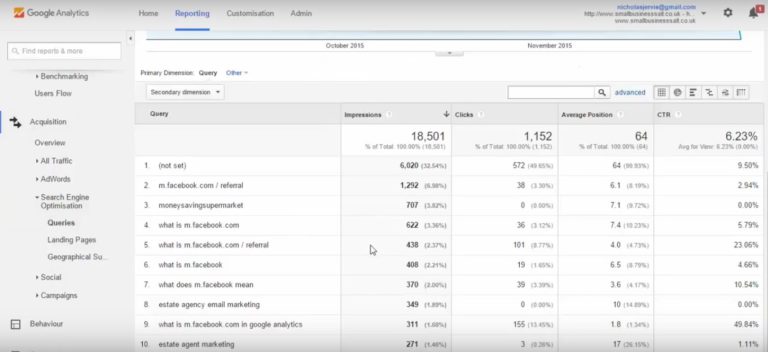
Are the pages showing for the keywords they were optimised for or something else entirely? Look out for discrepancies to see if you have been optimising for the right terms and putting your efforts behind the most popular content.
Extra tips for better CTR across both paid and organic search
- Tempt the user – To encourage CTR offer something valuable, whether it is money off your main conversions or a freebie to tempt micro conversions, both can increase CTR.
- Use descriptive URLs – Descriptive, relevant URLs work better than generic ones in both paid search and organic. Try to prove to users the landing page will be relevant to their query.
CTR is powerful but it does have weaknesses and we would always encourage businesses to measure multiple metrics to understand all their data. Forbes rather pessimistically predict the end of organic CTR by 2020 due to factors like Google’s knowledge graph.
While this seems a wild exaggeration, there are some forms of advertising and content for which CTR may be taking a back seat. SEMPost reports marketers regard CTR as the least important metric in video campaigns.
It is true CTR cannot be viewed alone, especially when considering new ad formats like video, where impressions and time watched are incredibly important. However, if users didn’t then click through to your site after viewing, it would be safe to say you would be disappointed.
This is why CTR is the ‘meat and potatoes’ of both PPC and SEO and should never be treated as a second rate metric. Work hard to improve your CTR and you will find better data and conversions soon follow.
